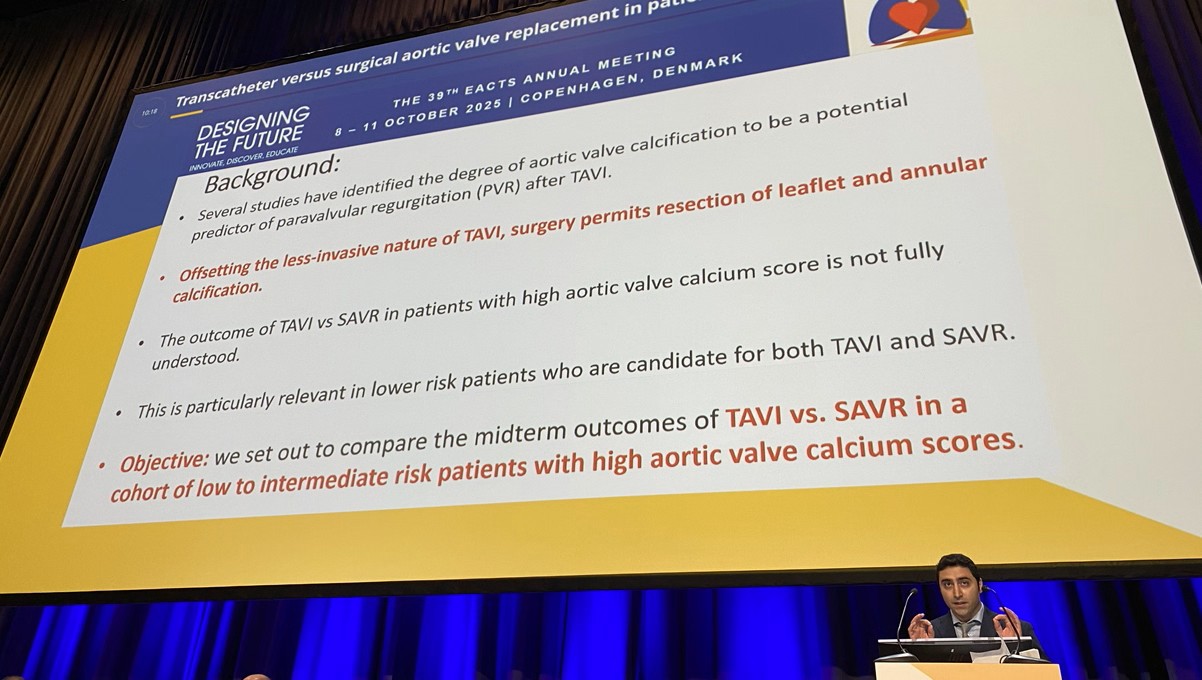The results underscore the need to perform CT imaging when deciding between procedures in patients with aortic stenosis.
COPENHAGEN, Denmark—Among patients with severe aortic stenosis at low- or intermediate-risk for surgery who also have very calcified aortic valves, SAVR is associated with lower risks of all-cause mortality, paravalvular regurgitation, and heart failure hospitalization compared with TAVI, according to new single-center data.
“[A] calcium score could potentially be an important criteria to consider when deciding between TAVI versus SAVR in low- and intermediate-risk patients,” said Fadi Hage, MD (Lankenau Medical Center, Wynnewood, PA), who presented the findings at the 2025 European Association for Cardio-Thoracic Surgery meeting. “Further investigation into predictors of outcomes in lower-risk patients is warranted to improve patient selection and [make] a more informed heart team discussion.”
Session moderator Alicja Zientara, MD (Universitätsklinikum Freiburg, Germany), said the results highlight the need for imaging in assessing patients for TAVI.
“It’s not only about the clinical risk factors of patients and choosing the right valve, but very much about imaging and evaluating if a TAVR is very well feasible for a patient,” she told TCTMD. “We know that there is a risk of aortic regurgitation and there is a risk of pacemaker, and not every patient necessarily is the right one for this kind of treatment. So, we as surgeons have to work very much on implementing regular imaging in our daily practice to also evaluate the valve, like cardiologists do.”
Better Outcomes With SAVR
The analysis included 227 patients who underwent TAVI (mean age 82 years; 77% male) and 99 who had SAVR (mean age 68 years; 88% male) at their institution between June 2021 and December 2023. All patients were considered low-to-intermediate risk for surgery and had a high aortic valve calcium score (≥ 3,000 Agatston units). More patients in the TAVI arm had peripheral vascular disease (20% vs 6%) and fewer had bicuspid aortic valve anatomy (4% vs 39%) than in the surgery arm.
In a propensity score-matched analysis, survival at 2 years was higher in the SAVR arm compared with TAVI (HR 0.17; P = 0.001). The same relationship was seen for freedom from paravalvular regurgitation (HR 0.05; P = 0.001) and heart failure rehospitalization (HR 0.33; P = 0.045). Unadjusted analyses showed advantages for SAVR over TAVI with regard to survival and freedom from paravalvular regurgitation, but not freedom from heart failure rehospitalization.
There was a higher risk of new permanent pacemaker with TAVI compared with SAVR at 30 days (16% vs 6%; P = 0.01), but a lower rate of postoperative transfusion (7% vs 36%; P < 0.001).
During the discussion, session panelist Ferdinand Vogt, MD (Paracelsus Medical University Nürnberg, Germany), pointed out a challenge for surgeons. “In the real world, we don’t have for every surgical patient an Agatston score,” he said, questioning whether this creates a “bias” in real-world practice when patients are deciding between TAVI and surgery.
“It would be an important thing to consider,” Hage responded, adding that it’s not “very difficult to get” this information.
In an informal poll of the audience, about one-third in the room raised their hands indicating that they do send patients for calcium score imaging before the procedure.
Zientara said she was “a little” surprised by how few of the attendees use this kind of imaging in their workups. “But on the other hand, it’s always a hot topic,” she added. “We have new guidelines for the treatment of those patients where there are different opinions.”
Panelist Gregory Fontana, MD (Cardiovascular Institute of Los Robles Health System, Thousand Oaks, CA), commented that CT scans prior to SAVR have “become the gold standard” at his institution.
Hage, too, said he calculates his own CT measurements for each patient, enabling him to be “nonbiased.” As surgeons, he added, “we should select the right procedure for the right patients.”
